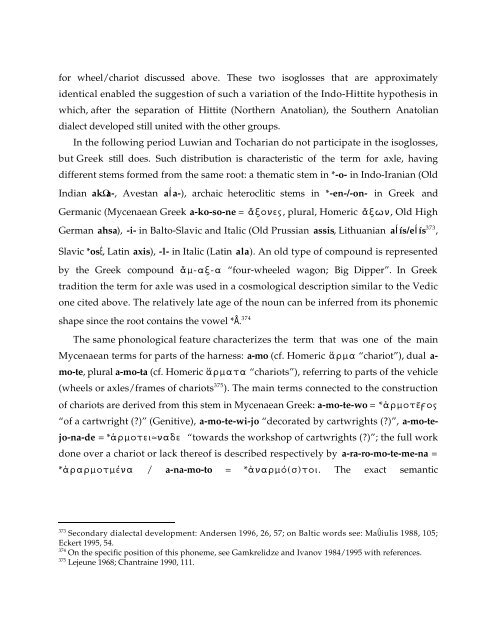Comparative Notes on Hurro-Urartian, Northern Caucasian
Comparative Notes on Hurro-Urartian, Northern Caucasian
Comparative Notes on Hurro-Urartian, Northern Caucasian
You also want an ePaper? Increase the reach of your titles
YUMPU automatically turns print PDFs into web optimized ePapers that Google loves.
for wheel/chariot discussed above. These two isoglosses that are approximately<br />
identical enabled the suggesti<strong>on</strong> of such a variati<strong>on</strong> of the Indo-Hittite hypothesis in<br />
which, after the separati<strong>on</strong> of Hittite (<strong>Northern</strong> Anatolian), the Southern Anatolian<br />
dialect developed still united with the other groups.<br />
In the following period Luwian and Tocharian do not participate in the isoglosses,<br />
but Greek still does. Such distributi<strong>on</strong> is characteristic of the term for axle, having<br />
different stems formed from the same root: a thematic stem in *-o- in Indo-Iranian (Old<br />
Indian akΩa-, Avestan aÍa-), archaic heteroclitic stems in *-en-/-<strong>on</strong>- in Greek and<br />
Germanic (Mycenaean Greek a-ko-so-ne = êj<strong>on</strong>ew, plural, Homeric êjvn, Old High<br />
German ahsa), -i- in Balto-Slavic and Italic (Old Prussian assis, Lithuanian aÍís/eÍís 373 ,<br />
Slavic *osÈ, Latin axis), -l- in Italic (Latin ala). An old type of compound is represented<br />
by the Greek compound êm-aj-a “four-wheeled wag<strong>on</strong>; Big Dipper”. In Greek<br />
traditi<strong>on</strong> the term for axle was used in a cosmological descripti<strong>on</strong> similar to the Vedic<br />
<strong>on</strong>e cited above. The relatively late age of the noun can be inferred from its ph<strong>on</strong>emic<br />
shape since the root c<strong>on</strong>tains the vowel *Å. 374<br />
The same ph<strong>on</strong>ological feature characterizes the term that was <strong>on</strong>e of the main<br />
Mycenaean terms for parts of the harness: a-mo (cf. Homeric ërma “chariot”), dual a-<br />
mo-te, plural a-mo-ta (cf. Homeric ërmata “chariots”), referring to parts of the vehicle<br />
(wheels or axles/frames of chariots 375 ). The main terms c<strong>on</strong>nected to the c<strong>on</strong>structi<strong>on</strong><br />
of chariots are derived from this stem in Mycenaean Greek: a-mo-te-wo = *èrmoteWow<br />
“of a cartwright (?)” (Genitive), a-mo-te-wi-jo “decorated by cartwrights (?)”, a-mo-te-<br />
jo-na-de = *èrmotei≈nade “towards the workshop of cartwrights (?)”; the full work<br />
d<strong>on</strong>e over a chariot or lack thereof is described respectively by a-ra-ro-mo-te-me-na =<br />
*érarmotm°na / a-na-mo-to = *énarmÒ(s)toi. The exact semantic<br />
373 Sec<strong>on</strong>dary dialectal development: Andersen 1996, 26, 57; <strong>on</strong> Baltic words see: MaÛiulis 1988, 105;<br />
Eckert 1995, 54.<br />
374 On the specific positi<strong>on</strong> of this ph<strong>on</strong>eme, see Gamkrelidze and Ivanov 1984/1995 with references.<br />
375 Lejeune 1968; Chantraine 1990, 111.





